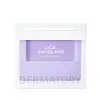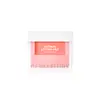What's inside
What's inside
 Key Ingredients
Key Ingredients

 Benefits
Benefits

 Concerns
Concerns

 Ingredients Side-by-side
Ingredients Side-by-side

Water
Skin ConditioningButylene Glycol
HumectantMethylpropanediol
SolventGlycerin
HumectantDipropylene Glycol
HumectantGuaiazulene
AntimicrobialChrysanthemum Parthenium Extract
Skin ConditioningChamomilla Recutita Extract
Skin ConditioningCentella Asiatica Leaf Extract
Skin ConditioningSea Water
HumectantBetula Alba Juice
AstringentChrysanthemum Boreale Flower Extract
AntioxidantGlycyrrhiza Glabra Root Extract
BleachingSodium Hyaluronate
HumectantHydrolyzed Collagen
EmollientAlthaea Rosea Flower Extract
Skin ConditioningRosa Centifolia Flower Water
Skin ConditioningHoney Extract
HumectantOlea Europaea Fruit Oil
MaskingHydroxyacetophenone
AntioxidantAllantoin
Skin ConditioningHydroxyethylcellulose
Emulsion Stabilising1,2-Hexanediol
Skin ConditioningCaprylyl Glycol
EmollientHydroxyethyl Urea
HumectantEthylhexylglycerin
Skin ConditioningTromethamine
BufferingSodium Carboxymethyl Beta-Glucan
CleansingPolysorbate 80
EmulsifyingPentylene Glycol
Skin ConditioningOctanediol
Caffeine
Skin ConditioningCarbomer
Emulsion StabilisingDisodium EDTA
Water, Butylene Glycol, Methylpropanediol, Glycerin, Dipropylene Glycol, Guaiazulene, Chrysanthemum Parthenium Extract, Chamomilla Recutita Extract, Centella Asiatica Leaf Extract, Sea Water, Betula Alba Juice, Chrysanthemum Boreale Flower Extract, Glycyrrhiza Glabra Root Extract, Sodium Hyaluronate, Hydrolyzed Collagen, Althaea Rosea Flower Extract, Rosa Centifolia Flower Water, Honey Extract, Olea Europaea Fruit Oil, Hydroxyacetophenone, Allantoin, Hydroxyethylcellulose, 1,2-Hexanediol, Caprylyl Glycol, Hydroxyethyl Urea, Ethylhexylglycerin, Tromethamine, Sodium Carboxymethyl Beta-Glucan, Polysorbate 80, Pentylene Glycol, Octanediol, Caffeine, Carbomer, Disodium EDTA
Water
Skin ConditioningGlycerin
HumectantPolyglycerin-3
HumectantPropanediol
SolventNiacinamide
SmoothingMethylpropanediol
SolventHydrolyzed Collagen
EmollientSodium Hyaluronate
HumectantMelia Azadirachta Flower Extract
Skin ConditioningOcimum Sanctum Leaf Extract
Skin ConditioningMelia Azadirachta Leaf Extract
Skin ConditioningCurcuma Longa Root Extract
MaskingCorallina Officinalis Extract
Skin ConditioningVincetoxicum Atratum Extract
Skin ConditioningMadecassoside
AntioxidantRetinal
Skin ConditioningAlthaea Rosea Flower Extract
Skin ConditioningHydroxyacetophenone
AntioxidantAllantoin
Skin ConditioningEthylhexylglycerin
Skin ConditioningAdenosine
Skin ConditioningCaprylyl Glycol
Emollient1,2-Hexanediol
Skin ConditioningPolyglyceryl-10 Isostearate
Skin ConditioningButylene Glycol
HumectantSodium Phytate
Polyglyceryl-10 Oleate
Skin ConditioningTocopherol
AntioxidantCapryloyl Salicylic Acid
ExfoliatingPanthenol
Skin ConditioningHydrolyzed Elastin
EmollientCaffeine
Skin ConditioningXanthan Gum
EmulsifyingWater, Glycerin, Polyglycerin-3, Propanediol, Niacinamide, Methylpropanediol, Hydrolyzed Collagen, Sodium Hyaluronate, Melia Azadirachta Flower Extract, Ocimum Sanctum Leaf Extract, Melia Azadirachta Leaf Extract, Curcuma Longa Root Extract, Corallina Officinalis Extract, Vincetoxicum Atratum Extract, Madecassoside, Retinal, Althaea Rosea Flower Extract, Hydroxyacetophenone, Allantoin, Ethylhexylglycerin, Adenosine, Caprylyl Glycol, 1,2-Hexanediol, Polyglyceryl-10 Isostearate, Butylene Glycol, Sodium Phytate, Polyglyceryl-10 Oleate, Tocopherol, Capryloyl Salicylic Acid, Panthenol, Hydrolyzed Elastin, Caffeine, Xanthan Gum
Ingredients Explained
These ingredients are found in both products.
Ingredients higher up in an ingredient list are typically present in a larger amount.
1,2-Hexanediol is a synthetic liquid and another multi-functional powerhouse.
It is a:
- Humectant, drawing moisture into the skin
- Emollient, helping to soften skin
- Solvent, dispersing and stabilizing formulas
- Preservative booster, enhancing the antimicrobial activity of other preservatives
Allantoin is a soothing ingredient known for its protective and moisturizingg properties. Because of this, it is often added to products with strong active ingredients.
Studies show higher concentrations of this ingredient can promote wound healing.
Though it can be derived from the comfrey plant, allantoin is produced synthetically for cosmetic products to ensure purity.
Learn more about AllantoinThis ingredient comes from the hollyhock flower. It has skin conditioning properties.
Butylene Glycol (or BG) is used within cosmetic products for a few different reasons:
Overall, Butylene Glycol is a safe and well-rounded ingredient that works well with other ingredients.
Though this ingredient works well with most skin types, some people with sensitive skin may experience a reaction such as allergic rashes, closed comedones, or itchiness.
Learn more about Butylene GlycolCaffeine is most associated with coffee, tea, and cacao. In skincare, it helps with calming inflammation and is rich in antioxidants.
While caffeine is used to treat cellulite and and dark circles, further studies are needed to prove this. It has been believed to help with these skin conditions due to its ability to dilate blood vessels and increase blood flow.
Some studies are looking into caffeine's ability to protect against UV rays.
Learn more about CaffeineCaprylyl Glycol is a humectant and emollient, meaning it attracts and preserves moisture.
It is a common ingredient in many products, especially those designed to hydrate skin. The primary benefits are retaining moisture, skin softening, and promoting a healthy skin barrier.
Though Caprylyl Glycol is an alcohol derived from fatty acids, it is not the kind that can dry out skin.
This ingredient is also used as a preservative to extend the life of products. It has slight antimicrobial properties.
Learn more about Caprylyl GlycolEthylhexylglycerin (we can't pronounce this either) is commonly used as a preservative and skin softener. It is derived from glyceryl.
You might see Ethylhexylglycerin often paired with other preservatives such as phenoxyethanol. Ethylhexylglycerin has been found to increase the effectiveness of these other preservatives.
Glycerin is already naturally found in your skin. It helps moisturize and protect your skin.
A study from 2016 found glycerin to be more effective as a humectant than AHAs and hyaluronic acid.
As a humectant, it helps the skin stay hydrated by pulling moisture to your skin. The low molecular weight of glycerin allows it to pull moisture into the deeper layers of your skin.
Hydrated skin improves your skin barrier; Your skin barrier helps protect against irritants and bacteria.
Glycerin has also been found to have antimicrobial and antiviral properties. Due to these properties, glycerin is often used in wound and burn treatments.
In cosmetics, glycerin is usually derived from plants such as soybean or palm. However, it can also be sourced from animals, such as tallow or animal fat.
This ingredient is organic, colorless, odorless, and non-toxic.
Glycerin is the name for this ingredient in American English. British English uses Glycerol/Glycerine.
Learn more about GlycerinHydrolyzed collagen has a misleading name because it is actually a mixture of various proteins/peptides. This ingredient has skin hydrating properties.
Collagen is the most abundant type of structural protein found in your body. In your skin, it is responsible for keeping it firm and youthful.
Hydrolyzed Collagen is created by breaking up proteins into smaller peptide bonds. These peptides act as humectants and emollients.
Humectants are great at holding onto water, keeping skin hydrated. Emollients create a thin barrier on the skin to prevent moisture from escaping.
There is ongoing debate about whether hydrolyzed collagen works because it increases skin hydration. Skin hydration is also linked to elasticity and the appearance of wrinkles.
Collagen or peptide ingredients can be used in the morning or night. They will not increase sun sensitivity, but you should always wear sunscreen during the day.
According to a manufacturer, this ingredient is a great hair conditioner as well.
This ingredient can be extracted from different sources, including:
Vegan collagen is derived from yeast, bacteria, or plant sources. Vegan collagen would go by a different INCI name, such as hydrolyzed soy protein.
The results are varied.
A study from 2021 found hydrolyzed collagen increased elasticity and improved wrinkles in 1,125 participants between age 20 and 70. Another study found increased skin thickness in participants between the ages of 45 to 59.
However, It is difficult to prove that oral collagen will end up working on your skin. Many of the studies using hydrolyzed collagen also add several vitamins and nutrients into the test mixture as well.
Further studies are needed at this time.
Learn more about Hydrolyzed CollagenHydroxyacetophenone is antioxidant with skin conditioning and soothing properties. It also boosts the efficiency of preservatives.
This ingredient is not irritating or sensitizing.
Methylpropanediol is a synthetic solvent and humectant.
As a solvent, it helps dissolve other ingredients, helping to evenly distribute ingredients throughout the product. This ingredient has also been shown to have antimicrobial properties which makes it a preservative booster.
Methylpropanediol is able to add a bit of moisture to the skin. It also helps other ingredients be better absorbed into the skin, such as salicylic acid.
Learn more about MethylpropanediolSodium Hyaluronate is hyaluronic acid's salt form. It is commonly derived from the sodium salt of hyaluronic acid.
Like hyaluronic acid, it is great at holding water and acts as a humectant. This makes it a great skin hydrating ingredient.
Sodium Hyaluronate is naturally occurring in our bodies and is mostly found in eye fluid and joints.
These are some other common types of Hyaluronic Acid:
Learn more about Sodium HyaluronateWater. It's the most common cosmetic ingredient of all. You'll usually see it at the top of ingredient lists, meaning that it makes up the largest part of the product.
So why is it so popular? Water most often acts as a solvent - this means that it helps dissolve other ingredients into the formulation.
You'll also recognize water as that liquid we all need to stay alive. If you see this, drink a glass of water. Stay hydrated!
Learn more about Water